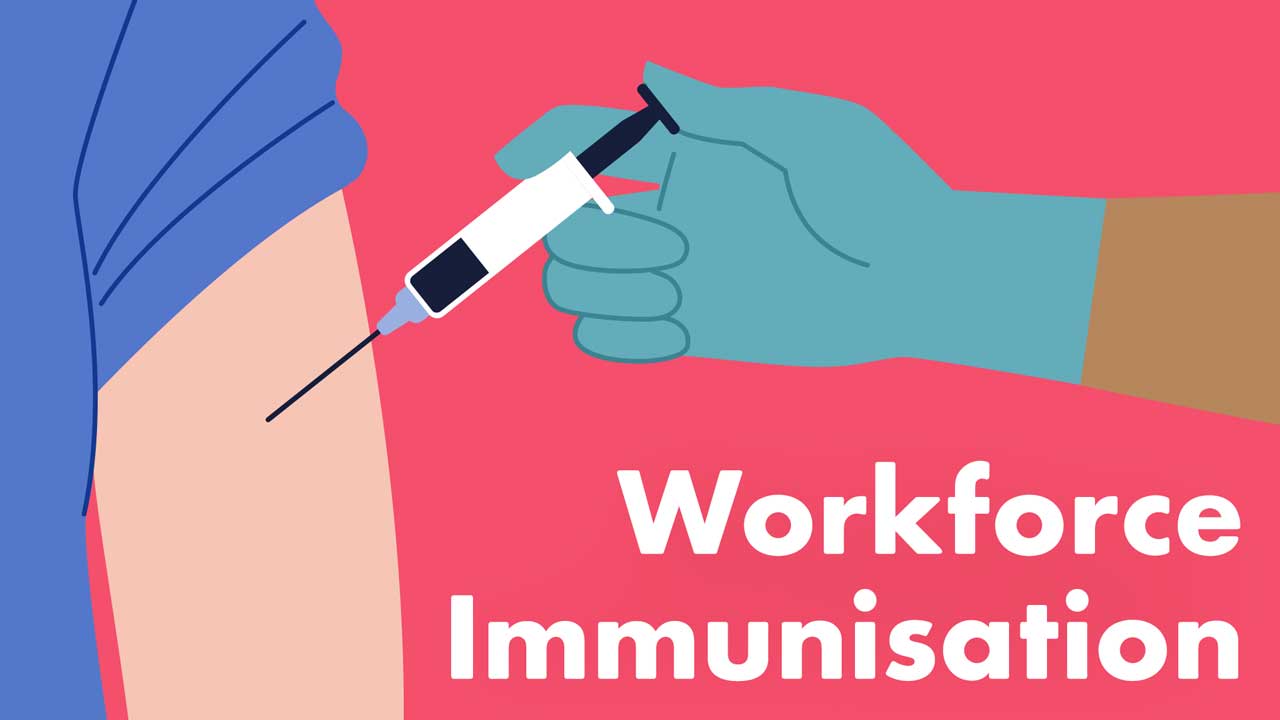Workforce Immunisation for Healthcare Staff
Published: 20 July 2023

Published: 20 July 2023

Due to the nature of their work, healthcare workers are at increased risk of encountering, contracting and spreading vaccine-preventable diseases.
To protect their staff and the patients in their care, particularly those who are vulnerable (e.g. young children, pregnant patients and older adults), health service organisations are expected to maintain a workforce immunisation program and encourage all staff to be vaccinated (DoHaAC 2022).
Workforce immunisation is outlined in Action 3.15 of the National Safety and Quality Health Service Standards, under Standard 3: Preventing and Controlling Infections.
This action aims to protect healthcare workforces and patients from vaccine-preventable diseases. Providers are required to have a risk-based workforce screening and immunisation program that:
(ACSQHC 2019)

The Australian Immunisation Handbook outlines the following recommendations for healthcare staff:
| Vaccine | Recommended for: |
| Hepatitis B | All healthcare workers |
| Influenza | All healthcare workers |
| Measles-mumps-rubella (MMR) | All healthcare workers who are non-immune |
| Pertussis (dTpa [diphtheria-tetanus-acellular pertussis]) | All healthcare workers |
| Varicella | All healthcare workers who are non-immune |
| Hepatitis A |
|
| Bacille Calmette–Guérin (BCG) | Healthcare workers at high risk of exposure to drug-resistant tuberculosis (depending on state or territory guidelines) |
(AIH 2021)
Note: While the Australian Immunisation Handbook provides recommendations, individual states and territories may have mandated vaccination requirements that healthcare workers need to follow. Make sure you refer to your jurisdiction’s guidelines (AIH 2021).
For example, in Victoria, healthcare workers who are employed in certain healthcare settings are required to be fully vaccinated against COVID-19 (Health.vic 2023).
The following matrix, developed by the Australian Commission on Safety and Quality in Health Care, is designed to determine the risk posed to an individual healthcare organisation by vaccine-preventable diseases (ACSQHC 2023).
| Workforce vaccination status and access to workforce screening | ||||
| Risk of disease exposure |
|
|
|
|
| No increased risk of exposure to disease or infection | Low | Medium | High | |
| Staff have a risk of exposure to vaccine-preventable disease due to the nature of their role | Medium | High | Very high | |
| Hospital-based outbreak of vaccine-preventable disease (no evidence of community transmission) | Medium | High | Very high | |
| Community-wide outbreak of a vaccine-preventable disease | High | Very high | Very high | |
| Disease with no available vaccine | Very high | Very high | Very high | |
| Low | The risk can be managed by routine procedures and there is minimal risk of harm or injury from the risk. |
| Medium | The risk can be managed by specific monitoring or audit procedures. There is potential for harm or injury from the risk. |
| High | There is a serious risk that must be managed immediately. Consequences to individuals and the organisation are high due to a high potential for harm or injury. |
| Very high | There is a serious risk that must be addressed immediately. The magnitude of the consequences to the individual and organisation of an event, should it occur, are considered very high with potentially significant harm or injury. |
(All tables adapted from ACSQHC 2023)
Once the risk level has been assessed, the organisation is expected to establish an action plan to address these identified risks (ACSQHC 2023).
The following strategies may help encourage staff to participate in annual influenza vaccinations and other vaccination programs:
(Queensland Health 2019)

While health service organisations may keep records of vaccinations administered at work, staff should also keep personal records so that they can easily keep track of their immunisation status (Better Health Channel 2022).
Healthcare staff may need to provide documentation proving they have received certain vaccinations (AIH 2021).
Any vaccines administered after 1996 are recorded on the Australian Immunisation Register (Better Health Channel 2022).
In order to protect staff and patients from vaccine-preventable diseases, health service organisations have a responsibility to establish policies, procedures and protocols as part of a comprehensive workforce immunisation program.
Question 1 of 3
A healthcare organisation does not have access to up-to-date vaccination records for all its staff members, but does have a workforce screening/ vaccination program in place. What is the organisation’s risk level in the event of an organisation-based outbreak of a vaccine-preventable disease?